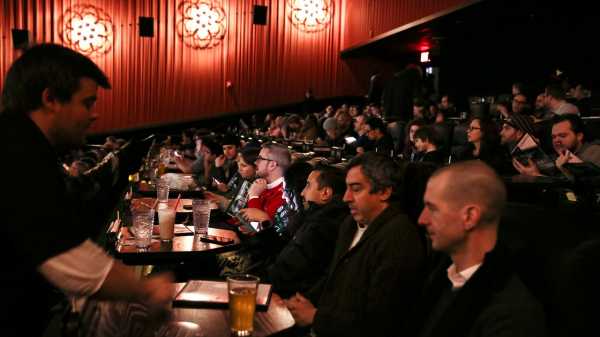
The other day, I dug up an e-mail that I sent to a friend in 2011, in which I reported, with great excitement, that I’d been to Nitehawk, a new movie theatre in Williamsburg, “where you can ORDER FOOD from your seat!” During a showing of “Martha Marcy May Marlene,” an indie thriller about a cult, I had feasted, apparently, on tater tots, corn dogs, beer, a steak sandwich, and an ice-cream sundae. In retrospect, my enthusiasm surprises me: the only thing I remember about that meal is feeling the tension shattered, during a suspenseful scene, by a server standing directly in my line of vision, and the vague dissatisfaction of eating in the dark.
Moviegoers have been eating in theatres for about as long as theatres have existed, in large part because theatres need us to. When the Great Depression threatened the movie-theatre business, owners started, somewhat reluctantly, selling cheap concessions at high margins. It was an instant success, and food has kept theatres afloat ever since, accounting, in recent years, for as much as forty per cent of profits. But as box-office numbers suffer—thanks, in part, to the culture of streaming movies and shows at home on the couch—more theatres (including, even, certain branches of the mega-chain AMC) are attempting to make theatregoing both as comfortable as being at home and as exciting, and expensive, as going to a restaurant. And why not? Sometimes popcorn and candy simply aren’t enough, a truth I learned early on, from my late grandmother, who used to smuggle foil-wrapped hamburgers into theatres, hidden beneath the knitting in her tote bag.
Each dine-in theatre adheres to a similar system: every two seats share a table, with plenty of space between rows for servers to stand or crouch. To order, there are golf pencils and slips of paper; using the light of a bulb embedded in the underside of your table, you write down what you want, then place the paper upright in a slot on top of the table. Servers come by every so often to snatch the papers, then to notify you of last call, then to drop your check.
In New York, there are three such theatres. Nitehawk will add a fourth later this year, when it opens a location in the former Pavilion, an art-deco theatre, in Park Slope, that was best known, in the years before it shuttered, for being in a state of disrepair. If the Nitehawk is a slightly pretentious but eager Brooklyn hipster—retro-looking interior design, mostly indie and art-house films, craft beer on tap, artisanal junk food—the Alamo Drafthouse, an Austin-based chain, is its more mainstream, slightly dorky cousin. The New York outpost, which opened in 2016, is in a mall, in Downtown Brooklyn, above a Target. Its attached cocktail bar, House of Wax, is decorated with anatomical models from a nineteenth-century wax museum.
The other night, a couple of friends and I went to the Alamo for a 6 P.M. showing of Jason Reitman’s “Tully,” about an overwhelmed pregnant mother of two (Charlize Theron) whose life, after a third baby arrives, is transformed by the arrival of a night nurse. I perused the menu, which, as at any chain restaurant, included calorie counts for each item. Was a “Brooklyn Brisket Burger” that I wouldn’t even be able to get a good look at worth 1,340 of them? I opted instead for the “Southwestern Tofu & Quinoa Bowl” (595 calories).
When the dish arrived, I held it under the table to peer at it in the light. It looked and tasted fine, like something you might get at a chopped-salad bar. I ate it steadily, in between sips of a glass of 2016 Grüner Veltliner—until the scene in which Theron’s character gives birth. My appetite returned by the time my cookie trio (chocolate chip, double chocolate, peanut butter and banana) arrived, just ten minutes before the closing credits. To be fair, they were baked to order, and as satisfying as the movie’s twist ending.
Both the Alamo Drafthouse and Nitehawk offer food-and-drink specials contrived to fit thematically with the movies they’re showing. After the Alamo’s “Deadpool 2”-themed “chimi-freakin-changas,” Nitehawk’s “RBG” offerings seemed positively charming, featuring “local products from female-owned, Brooklyn-based businesses.” I ordered both: the Brooklynite: Born and “Bread” (Salvatore Bklyn ricotta, orange supremes, oregano, truffle honey, sea salt, grilled organic seven-grain bread) and the Duchess of Krakenthorp, a rum-based cocktail made with apricot liqueur and fig bitters, named after a character in Donizetti’s “La Fille du Régiment.” The Washington National Opera, I learned from the film, invited R.B.G., a great lover of opera, to play the Duchess (a small, non-singing role), in a 2016 production.
I had arrived at the theatre early, hoping to order before the previews began, but my server, whisking up and down the rows around me, an apron tied neatly around her waist, proved vexingly immune to my efforts to make eye contact. (“Reacting in anger or annoyance will not advance one’s ability to persuade,” R.B.G. once said, wisely.) The menu’s artisanal-Brooklyn veneer faded once the food arrived. The Born and “Bread” had neither the texture nor the temperature you’d expect from toast made on a grill, and the orange was cut not in supremes but in paltry chunks. The film, however, was so moving that I wept into my Duchess of Krakenthorp.
Neither experience rose above the level of novelty—supposedly fun meals I’ll never have again. I do appreciate that the popcorn at both the Alamo and Nitehawk is much better than the standard-issue, chemical-y stuff scooped stale from a glass tank. It’s popped to order and comes in big metal bowls, with real melted butter. But I’d rather go to Film Forum, where the popcorn is pleasingly ascetic, completely plain unless you add salt, or to Metrograph, where it’s made with olive oil and sea salt, and where you can get a full meal before or after the show at a lovely restaurant on the mezzanine.
My colleague Richard Brody, who spends many of his waking hours watching movies, does not think food or drink should be involved in the theatre experience whatsoever. He won’t even eat before a showing, out of fear that it might leave him drowsy and inattentive. “Trends in movie-going comfort, from meal service to reclining seats, are meant to make the experience of viewing bad movies bearable,” he told me recently. “They only detract from any movie worth seeing for its own sake. The wanderings of waitstaff, however careful and considerate, the clink of silverware, even the Smell-O-Vision aroma factor, are unworthy distractions.”
I thought of his comments on a recent visit to the city’s third dine-in theatre, the iPic, in South Street Seaport, where I took in a matinee of “Book Club,” a “Sex and the City” knockoff that is depressingly beneath the talents of its four formidable female stars. The iPic, a chain with locations in nine states, is luxe in the generic manner of a high-end casino or an airport lounge, dark and sleek, with plush patterned carpets. Indeed, everything about it feels akin to air travel. Unlike at Nitehawk and Alamo, where the price of admission is the same as at any theatre, tickets here are tiered: to qualify for in-theatre dining, you must purchase “premium plus” seats, which cost sixteen dollars each, and pay a fourteen-dollar “V.I.P.” fee. As in first class on a plane, these seats are pod-like and feature cushy chairs that lie almost flat, controlled electronically, plus cup holders, small pillows, flimsy fleece blankets, and a call button to summon a server.
The only books that the women in “Book Club” read are the first two installments of “Fifty Shades of Grey” (though they mention “Fear of Flying” and “Moby-Dick” and reference something that sounds a lot like “Wild”). The only thing they consume is copious amounts of white wine, though many scenes feature them preparing, but never eating, elaborate cheese plates and other snacks. I didn’t eat much myself. My fries were flavored with—what else?—truffle oil, that ubiquitous yet unconvincing indicator of “luxury.” They were not particularly hot, and in the dark their Parmesan coating read as “furry.” I might have been impressed by the limp Green Goddess turkey sliders had they emerged from a convection oven in the galley on a jetliner, but what was this kitchen’s excuse? I wasn’t sure, in the end, if the food had made the movie more bearable, or if it was the other way around.
Sourse: newyorker.com






